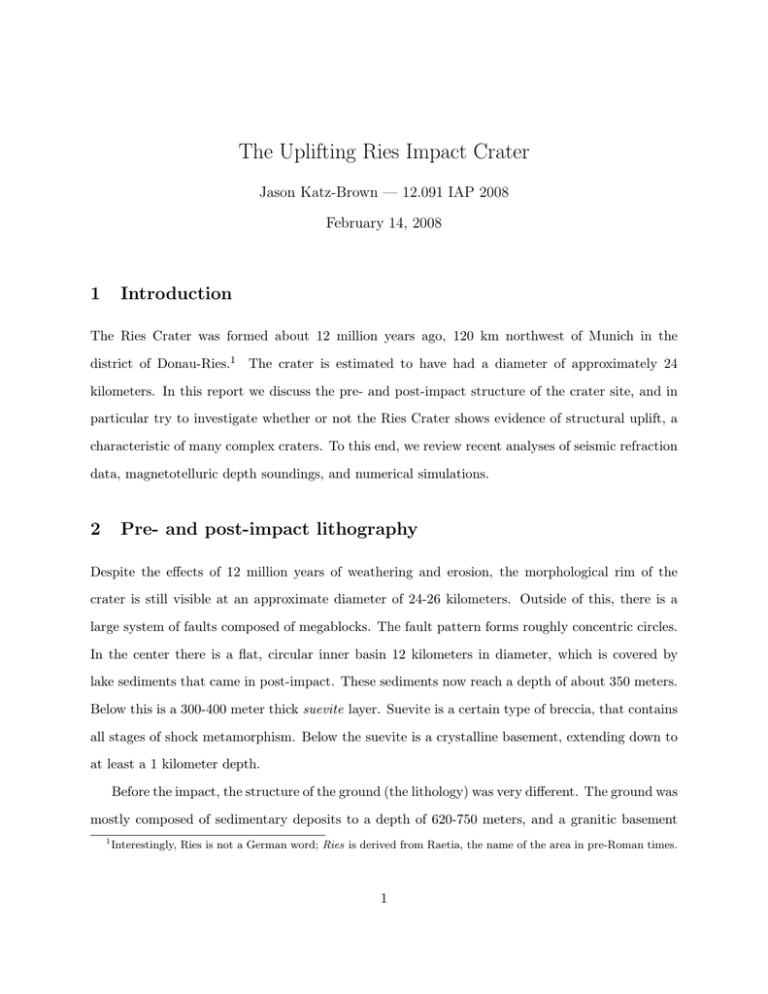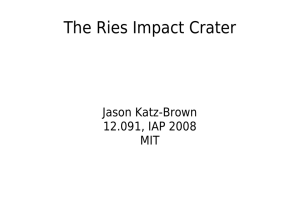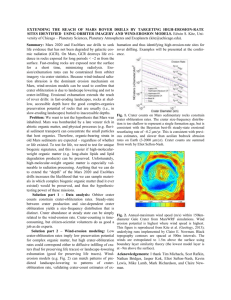Document 13515577
advertisement

The Uplifting Ries Impact Crater Jason Katz-Brown — 12.091 IAP 2008 February 14, 2008 1 Introduction The Ries Crater was formed about 12 million years ago, 120 km northwest of Munich in the district of Donau-Ries.1 The crater is estimated to have had a diameter of approximately 24 kilometers. In this report we discuss the pre- and post-impact structure of the crater site, and in particular try to investigate whether or not the Ries Crater shows evidence of structural uplift, a characteristic of many complex craters. To this end, we review recent analyses of seismic refraction data, magnetotelluric depth soundings, and numerical simulations. 2 Pre- and post-impact lithography Despite the effects of 12 million years of weathering and erosion, the morphological rim of the crater is still visible at an approximate diameter of 24-26 kilometers. Outside of this, there is a large system of faults composed of megablocks. The fault pattern forms roughly concentric circles. In the center there is a flat, circular inner basin 12 kilometers in diameter, which is covered by lake sediments that came in post-impact. These sediments now reach a depth of about 350 meters. Below this is a 300-400 meter thick suevite layer. Suevite is a certain type of breccia, that contains all stages of shock metamorphism. Below the suevite is a crystalline basement, extending down to at least a 1 kilometer depth. Before the impact, the structure of the ground (the lithology) was very different. The ground was mostly composed of sedimentary deposits to a depth of 620-750 meters, and a granitic basement 1 Interestingly, Ries is not a German word; Ries is derived from Raetia, the name of the area in pre-Roman times. 1 below. When the meteorite hit this target, a transient cavity of probably about one-third the diameter (4 kilometers) deep was formed. The crater floor now lies about 1 kilometer below the surface of the crater, so some process was responsible for the floor of the crater rising from its post-impact spot. As we learned in class, most complex craters have structural uplift, where the center of the crater is raised up. However, there have been no geophysical clues found to suggest the presence of a structural uplift in the Ries Crater. 3 Looking for structural uplift A team (Wünnemann, Morgan, and Jdicke) from the Imperial College London and Institut für Geophysik set out to reanalyze other data to uncover evidence of structural uplift that may have been overlooked in the past. They used these techniques, all of which we have seen in class: • Seismic refraction data • Magnetotelluric depth soundings • Numerical simulations To detect the structural uplift, they looked for three characteristics of rocks in structural uplift: an increase in seismic velocity, increase in density, and a change in magnetic or electrical signature. 3.1 Seismic refraction data The first data Wünnemann et al. reanalyzed was seismic refraction data to determine whether there is an increase in seismic velocity in the center. They found that inside the crater, one finds rocks with above 6.0 meters per second velocity at a depth of 2 kilometers. Outside the crater, not until going down at least 3 kilometers does one finds rocks with above 6.0 meters per second velocity. This suggests the presence of structural uplift, that would have raised the rocks with high seismic velocity seemingly about 1 kilometer. See Figure 2 in Wünnemann et al. 2 3.2 Magnetotelluric depth soundings Next, Wünnemann et al. looked at magnetotelluric (MT) data, which allowed them to study the distribution of electrical conductivity of the deep structure below the Ries crater. The MT method is used to detect highly conductive structures in deep subsurface. They used measurements over a 73 kilometer profile across the crater and surrounding area, with more measurements nearer to the crater center. Wünnemann et al. built several interpolation models that allowed them to plot resistance at different depths and distances from center. All the models showed a high-conductivity zone at the center of the crater, corresponding to the sedimentary and suevite layers (see Wünnemann et al. Figure 5). The most likely model also shows a very interesting fact: that there are no deep-reaching fractures below the crater. But these experiments do not seem to shed light on the question of whether Ries has a structural uplift. 3.3 Numerical simulations Finally, Wünnemann et al. turned to numerical simulation to investigate the chain of events during impact. They used the SALE hydrocode, the predecessor of SALE 2 mentioned in class. They had to determine the values of many parameters. For instance, they decided the impact velocity was 18 kilometers per second, and that the top sediment layer was 800 meters thick. For the rock, they set yield strength, pressure, temperature, internal friction, cohesion, and more. For the acoustic fluidization model, they set, viscosity and decay time, among others. These fluidization model parameters were strongly linked with fragmentation size of rocks beneath the resulting structure. Lower viscosity and longer decay time led to increased fragmentation. The main results from the simulations were brilliant plots of rock velocity at various points during the impact event, but these plots cannot be included here. See Wünnemann et al. Figures 7 and 8. Figure 8 even shows the total displacement of rocks at various places inside the crater, and one can see that rock in the center of the crater moved more than four times a greater distance than rock at the crater rim. This suggests that basement rocks were uplifted in the later stages of the impact event. Another notable thing from the plots is that some rocks were subjected to 3 greater than 50 gigapascals during impact! 4 Conclusion The Ries crater is a very well studied crater, formed approximately 12 million years ago by a crater of about 24 kilometers diameter. Although it has been assumed to not exhibit structural uplift in its center, and thus be a bit of a peculiar crater, recent analysis of seismic refraction data, magnetotelluric soundings, and numerical simulations suggests that Ries is a crater with typical structural uplift. 5 Bibliography • K Wünnemann, JV Morgan, H Jödicke. Is Ries crater typical for its size? An analysis based upon old and new geophysical data and numerical modeling. In: T. Kenkmann, F. Hrz and A. Deutsch, Editors, Large Meteorite Impacts III, Geol. Soc. Am., Boulder, CO (2005), pp. 6783 Special Paper 384. • R.M. Hough, I. Gilmour, C.T. Pillinger, J.W. Arden, R.W.R. Gilkes, J. Yuan and H.J. Milledge, Diamond and silicon carbide in impact melt rock from the Ries impact crater. Na­ ture 378 (1995), pp. 4144. • Graup, Genther. Carbonate-silicate liquid immiscibility upon impact melting, Ries Crater, Germany. Meteoritics & Planetary Science, vol. 34, no. 3, pp. 425-438 (1999). 4




